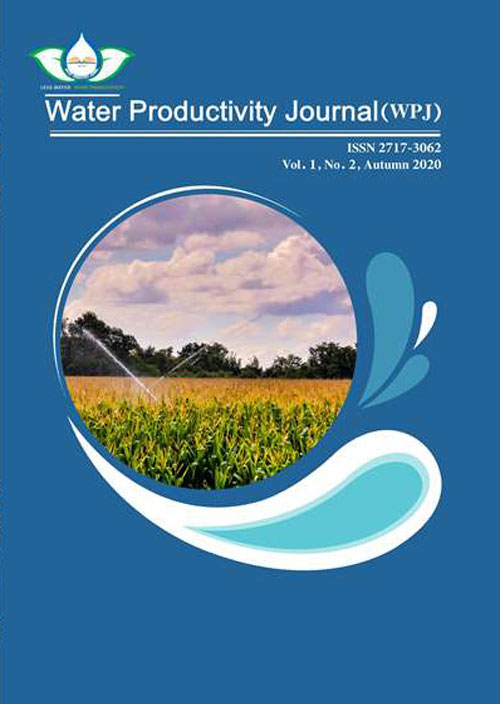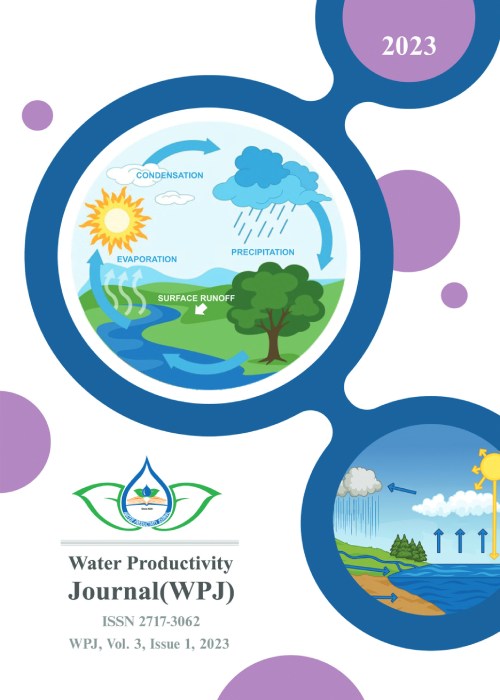فهرست مطالب

Water Productivity Journal
Volume:1 Issue: 3, Winter 2021
- تاریخ انتشار: 1400/01/05
- تعداد عناوین: 7
-
Pages 1-12Over the last three decades, climate change has emerged as one of the most crucial issues for humankind, with serious implications for sustainable development. In recent decades, changes in climate have caused the impacts on natural and human systems on all continents and across the oceans. Human activities are estimated to have caused approximately 1.0°C of global warming above pre-industrial levels, with a likely range of 0.8°C to 1.2°C. Global warming is likely to reach 1.5°C between 2030 and 2052 if it continues to increase at the current rate. Climate change increases variability in the water cycle, inducing extreme weather events such as droughts and more erratic storms, reducing the predictability of water availability, affecting water quality and threatening sustainable development and biodiversity worldwide. Agriculture is the sector most vulnerable to climate change due to its high dependence on climate and weather. It is important to determine the impacts of climate change on water resources in order to develop possible adaptation strategies to improve water productivity. This paper discusses the observed climate change over the past few decades; the climate change-induced impacts, such as rising sea levels, changing rainfall patterns, increased droughts, and more erratic storms; the future climate change; the climate change impacts on water productivity; and the strategies to improve the water productivity such as improved policies, emphasis on sustainability, improving water resource management and use of appropriate models.Keywords: climate change, sustainable development, Water Availability, Water productivity, Water Resources Management
-
Pages 13-24
In this paper, the evolution of runoff enhancement treatments on both natural and artificial (or roaded) catchments used for rainfall harvesting to supply small on-farm dams in south-western Australia is reviewed. Over the last seven decades, various experimental treatments and approaches to enhance water shedding or harvesting techniques have been tested and adapted across this region to account for variations in slope, soil type and rainfall distribution. These adaptations are vital to maintain water harvesting efficiency and water security in a drying climate and enable farmers to continue to produce crops and support livestock effectively while increasing their climate resilience. As such, water security is one of the most important components of any agricultural enterprise. The treatments or sealants evaluated, varied in their capacity, cost, durability or water shedding capability, to provide a robust response to changes experienced in rainfall patterns, their intensity and frequency due to climate change. This review has highlighted the potential to use various surface treatments to increase the water harvesting efficiency from different landscapes in semi-arid or dryland agricultural areas in southwestern Australia.
Keywords: Artificial Catchments, Australia, Climate Resilience, Dryland Agriculture, Rainfall, water harvesting, Water security -
Pages 25-36
The Himalayas are one of the important and highest mountain ranges of the world spread over several countries. The region is rich in biodiversity and water resources. It is known as the third pole because of the largest glacier and ice reserve outside the two poles. This complex zone is highly critical and sensitive to the temperature fluctuations which is clearly visible in the changing dynamics of the glaciers present in the Himalayan region. Glaciers are an ideal sensor in this highly glaciated region to detect the causes and impacts of global warming. They form the backbone of this ecosystem especially the economy which makes the studies of the glaciers and climate change more important. This paper reviews the changing climatic scenario of the region with emphasis on the impacts on the glacier reserves. Various research findings have been put forth such as changing stream flows, decreased precipitation, increased frequency of extreme climate events, glacier shrinkage, expansion of glacier lakes and the glacier lake outburst floods. This detailed review of the previous studies will help in formulating the required strategies and management practices in the Himalayan region especially the water resources.
Keywords: climate change, Dynamics, Glaciers, Himalayas, Indus, rivers, runoff, Temperature, Water security -
Pages 37-50
The risk of flooding is the main natural hazard that affects the European region. This hazard has worsened in the recent decades due to the urban occupation of flood areas and the effects of climate change. Therefore, in Spain, interest in this subject is accentuated in the case of future teachers because this issue is mandatory to teach in primary education (grades 1–6; social sciences subject). The aims of this research are to explore the instruction about flooding received by future teachers during their school and university period and propose the instruction curricular activities to do in classroom (primary education). Methodologically, a questionnaire was distributed among future teachers of primary education (Faculty of Teaching Training of the University of Valencia, Spain) during three academic courses (2018-19, 2019-20 and 2020-21). Also, the current curriculum was analysed (Royal Decree 126/2014, of February 28, which establishes the basic curriculum for primary education). Some results regarding the respondents’ perception show that most of the respondent did not receive such training (68.3%) during their school period. And regard with the information received about floods during the university stage (primary education teacher degree), the majority of the respondents did not receive any formation (89.1%). With reference to the curricular proposal activities, they are characterized by the problematization (critical methodology; activities that student should resolve problems).
Keywords: Flood Adaptation, Flood management, Flood Risk, Socio-Hydrological, Water Education -
Pages 51-64Coastal ecological footprint (EF) forms one of the six components of the EF measure. It accounts for the marine area required to sustain current levels of seafood consumption within a nation. It is estimated by drawing on the calculation of net primary production or the amount of solar energy converted into organic matter through photosynthesis needed to support a fishery. Coastal ecosystems, found along continental margins are the regions of extraordinary productivity and accessibility which also makes them vulnerable to degradation. Hence studying their footprint becomes important. This paper seeks to find the driving factors behind the coastal EF using data from 117 countries for a period of two decades from 1992 to 2012. A set of economic, demographic, climatic and trade variables were found to have the biggest impact on coastal EF. Given that temperature has emerged as the most import driving factor coastal EF among the variables examined, policies to protect and restore coastal ecosystems go hand in hand with the policies to combat global warming and ties into the larger narrative of climate change that has sparked debate and controversy in recent times. It is necessary to have the international co-operation through organisations, conventions, agreements and everything in between because we know that the temperature fluctuations at unprecedented levels are a global phenomena. But countries inevitably give different levels of priority to the sustainable development of their coasts depending upon national interests.Keywords: Coastal ecological biocapacity, Coastal ecological footprint, Cross-national analysis, Ecological Footprint
-
Pages 65-78
Climate change is probably going to affect groundwater resources, in Sub-Saharan ccountries (SSA) in Africa either directly, by means of changing precipitation patterns, or indirectly through the combination of changing precipitation patterns with evolving land-use practices and water request. West Africa has, over the past few decades, experienced a sharp decline in rainfall and average annual flow of watercourses. A break in the rainfall pattern was observed around 1968-1972. 1970 is considered as the turning point after which the decline in average rainfall worsened from minus 15% to minus 30% depending on the zone. This situation led to the drifting of isohyets by about 200 km to the south. A 1°C increment in temperature could change overflow by 10%, expecting that precipitation levels stay consistent. Any reduction in groundwater recharge will intensify the impact of sea-level rise in coastal aquifers. For various reasons and at various levels, West African countries are dependent on one another. Over the past few decades, this interdependence has not only generated tension, but has also led to a dialogue and cooperation process. Only one country (Burkina Faso) are below the international standard for water scarcity (1,700 m3 of renewable fresh water per year per person); On the other hand, there are major problems in terms of availability at the desired time and place. According to the Global Water Partnership, the withdrawal level of renewable water resources in West Africa (excluding Cameroon and Chad) is currently at 11 billion m3 per year for an available 1,300 billion m3, which is less than 1%. Agriculture uses 75% of these withdrawals, domestic consumption 17%, and industry 7%. Although it is by far the highest in proportion, agricultural use of water resources is low. Out of the 75.5 million hectares of arable land in West Africa, only 1.2% (917,000 ha) is developed for irrigation, and 0.8% (635,000 ha) is used effectively.
Keywords: Groundwater management, Rainfall pattern, Sustainability, Water resources -
Pages 79-87The total area of the water surfaces in the Perm is 60.4 km2. Among the surface water resources, lakes and swamps play an important role. They are reservoirs of available water that form the ecological state of the territory. The Lasvinsky lakes (that have a total area of around 1247 hectares) are wetlands that can be classified as specially protected areas, which are of particular importance for the conservation, restoration and maintenance of wetland communities, waterfowl resources and their habitats. These water bodies are located in Perm. This million city with a developed engineering infrastructure and powerful industrial enterprises inevitably has a negative impact on the environment, including the water bodies. The Lasvinsky lakes experience significant anthropogenic impact, which affects the current ecological situation. It has been established that the Lasvinsky lakes are of natural origin, their main source is groundwater, the level of which is determined by the regulation of the Votkinsk reservoir. The lakes have different self-cleaning abilities and different conditions for the hydro-chemical regime formation and it helps water productivity.Keywords: Bottom Sediments, Hydro-Biological Indicators, Hydrochemistry, Pollution, Water productivity, Wetland Complex


